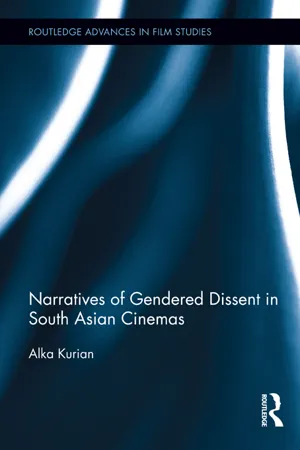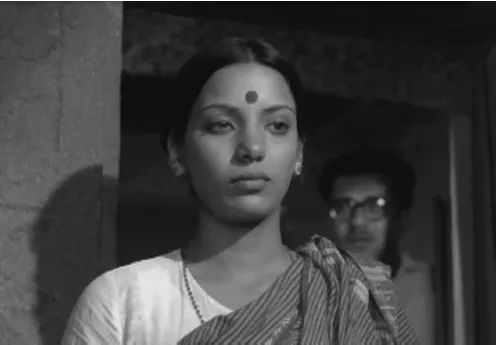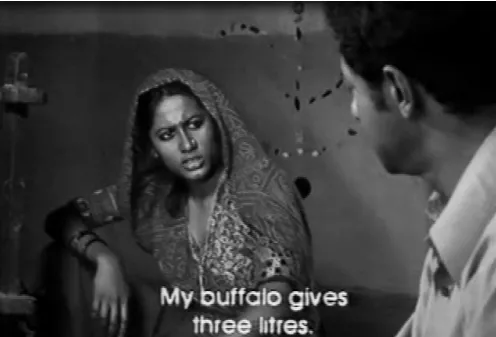![]()
Part I
Class, Caste, and Social Exclusion
![]()
1 Subalterneity and Resistance in Shyam Benegal’s Nishant and Manthan
Shyam Benegal is one of the leading Indian filmmakers whose work occupies a prominent place in the movement of ‘art’ cinema in the country. The appeal in 1970s and early 1980s of this genre of cinema, also known as parallel, alternative, or middle cinema, is attributed to the aesthetic value as well as commercial success provided by four of his films at a time which was generally considered to be bleak for non-mainstream films. This chapter discusses two of his landmark films Nishant (1975) and Manthan (1976) that form part of a quartet, the other two being Ankur (1973) and Bhumika (1977). The narrative in Nishant—based on Vijay Tendulkar’s short story—proceeds along the familiar lines of good winning over evil, reminiscent of India’s ancient epic tales of Mahabharata and Ramayana, at the heart of which lies a protracted battle fought over a woman trapped within heteronormative politics of intimacy, desire, and corruption. However, the victory of the good that ensues in these tales is neither sweet nor is it long-lasting, as shrouded beneath the surface is the memory of anarchy, bloodshed, the woman’s sexual pollution, and her violent erasure.
The start of the film Nishant provides rather vague information about the location where the narrative is set—somewhere in South India, 1945. In a recent discussion with the author, Benegal pointed out that the film was based on a real-life event that took place in the Telangana region in Hyderabad (Andhra Pradesh). Critics (Dutta, 2002, Virdi, 2009) too have associated the film’s politics of peasant revolt against systemic abuse, its timeframe, and location, with the Telangana uprising. The film tracks the tale of Sushila (Shabana Azmi), her school master husband (Girish Karnad) and their five-year-old son who have recently arrived in a village which is being ruled by the powerful zamindar’s1 family engaged in the villagers’ economic and sexual exploitation. Anna (Amrish Puri), the oldest unmarried brother, is the brutal patriarch who uses his younger brothers Anjaiya and Prasad for stealing from market vendors, throwing tenants off their land, and pimping young, gullible women into the manor house as sex slaves. His favorite is his youngest brother Vishwam (Naseeruddin Shah), a nervous and timid person who never challenges Anna’s authority and whose nascent vagrancy is kept in check by his levelheaded wife Rukmani (Smita Patil).
The school master and Sushila are distressed by the lawlessness, arrogance, and despotism of the Zamindar’s brothers. While the idealist schoolmaster gets on with his life and attempts to make the most of the practically defunct village school, the independent-minded, feisty, and sexually attractive Sushila, however, is restless and unhappy with their station in life. The school master patiently listens through her demands for material comfort—a full-length mirror, a sari. As a loving and caring couple devoted to their son, they are a contented family although from time to time the school master gets exasperated with Sushila’s unafraid demeanor and lack of selfawareness which, he fears, might arouse unsolicited male attention. Sushila is shown to unhesitatingly look on while the villagers are being bullied by the Zamindar’s brothers. It is during one of these moments that Vishwam gets drawn to her, something that does not bother Sushila who says: “One should throw chilli powder in their eyes. That’ll teach them”! This brings to mind women’s participation in the Telangana armed resistance where they used kitchen equipment and spices, especially chilli powder, as weapons (Virdi, 2009). The situation changes dramatically, however, as Sushila becomes victim of this brutal economy of desire and abuse as Vishwam is increasingly obsessed by her. Brazenly, and in front of her husband, son, and the villagers, she is abducted by Anjaiya and Prasad and driven off to the manor house where she is brutally gang raped and incarcerated. This is the central event around which the film is structured.
The schoolmaster’s attempts at rescuing his wife lead him nowhere: the manor house is like a fortress, the villagers are too frightened to give witness against the zamindar, and the local policeman deliberately turns a blind eye towards his corrupt and unforgiving family. Virdi refers to the school master as embodying a modern consciousness: he disregards the villagers’ suggestion that he remarries and forgets about his sexually-polluted wife; instead, he seeks help from modern institutions—“the court, the press, and higher administration” (2009: 156). However, here too he encounters failure: the busy District Magistrate is caught up in larger affairs of the region, and the editor of the local newspaper would rather not risk exposing the zamindar. Trapped within the manor house, Sushila makes peace with her situation and gives in to Vishwam, who is clearly in love with her; in doing so, not only is she able to unsettle his wife Rukmani’s position within the marriage, but also it gives her the ammunition to negotiate a space for herself as a mistress rather than a kept woman. While the attraction that the opulent lifestyle of the manor house holds for her has not been elaborated in the film, it cannot nonetheless be discounted, given the brief narrative of her propensity for material comfort. The schoolmaster, bitterly disappointed by the villagers’ meek response, the callous disregard and apathy of the law enforcement institutions and the media towards the corrupt feudal family, resigns himself to his fate and spends his time in isolation, taking care of his son. However, a chance encounter with Sushila in the temple, where she accuses him of emasculation, spurs him into action: with the help of the temple priest, he mobilizes the villagers into taking revenge. The narrative ends in a violent and anarchic nihilism in which Sushila, along with the entire feudal family, is killed. In the last scene we see a group of bewildered children sitting around the priest in the village temple.
While Nishant is structured around the insidious power of feudalism in colonial India, Benegal’s Manthan (1976) represents the reformist face of modern India’s interventionist state’s ‘socialist’ transformation of its rural areas. This Emergency2 film represents grass-roots mobilization of milk producers in rural Gujarat through the character of Dr. Manohar Rao (Girish Karnad), an intellectual bureaucrat. The film plots his long-drawn-out battle with the existing power structure in the village, involving the owner of the local dairy, Mishra (Amrish Puri), and the village leader, known as the Sarpanch (Kulbhushan Kharbanda), who together attempt to thwart his efforts. Dr. Rao however, finds two allies in his battle: Bhola (Naseeruddin Shah), the disaffected member of the Dalit community and an illegitimate son of a city engineer, who is frustrated with the sinister politics played by Mishra and Sarpanch and against whom he has lost the will to fight; then there is the Dalit Bindu (Smita Patil) who, despite being trapped in an abusive marriage, demonstrates unparalleled boldness and astute political insight into the nature of Dalit abjectness.
Figure 1.1 Sushila Accuses her Husband of Not Helping her Escape from the Zamin-Dar’s House.
Through their support, Dr. Rao wages a veritable revolution in the village: he and his city co-workers educate the villagers in improving milk production and preservation, win their confidence by offering them higher milk prices, and encourage them to form their own milk cooperative. But barely do his plans begin to crystallize that the irate Mishra-Sarpanch nexus burns down the village and implicate Bindu in a falsified rape testimony against Dr. Rao. The harassed villagers give up their dream of independence and Dr. Rao gets transferred out of the village. However, under Bhola’s leadership, the seed of self-reliance that Dr. Rao had sewn in the subaltern subconscious bears fruit. As is typical of Benegal’s films, the narrative ends with focusing on the youth: we see a young boy moving away from the line of milk producers outside Mishra’s dairy, symbolically breaking, in the process, the chain of Dalit oppression.
In his 1984 essay, Sumit Sarkar, one of the founders of the Subaltern Studies group, highlights the exclusion from elite historiography of resistance narratives of the subalterns whose political composition and radical activities unfolded in ways different to the anti-imperialistic struggles of the elites in colonial Bengal. The latter preferred to enforce Gandhian-style civil disobedience and non-violent resistance and misrepresented the lukewarm response of the masses to their strategies as yet another annoying example of mass political apathy. Sarkar skillfully counters dominant falsifications of the subaltern political consciousness by pointing out that popular militancy often erupted in response to harsh economic conditions. He is quick to draw attention, nevertheless, to the limitations of an economic justification alone, as it does not explain the “multiplicity of types of subaltern activity and their interpenetration” (Sumit Sarkar, 1984: 286)3. Below I will be exploring at length Benegal’s exemplification of this point in Nishant, where popular militancy is shown to be rooted in both economic and sexual exploitation. Sarkar quotes the example of a Swadeshi public protest in October 1907 at Beadon Square where several low-class people including sweepers and sheep-cattle keepers began attacking the Bengali Bhadralok. In their projection of subaltern combativeness as an instance of communal violence, claims the critic, the nationalist politicians deliberately overlooked traditional structures of abuse.
Figure 1.2 Bindu Tells Dr. Rao that it is the Owner of the Mishra Dairy who is Corrupt, and not the Milk Producers.
An insight into the agrarian system that was in place in Andhra Pradesh during the Nizam rule would throw light on the existing structures of power and subjugation towards which the subaltern resistance was geared, and which constitutes the narrative focus in Nishant. Occupancy of the land was based on what came to be called the Jagirdari system, an exceptionally exploitative hierarchical structure at the bottom of which were the peasants who had been reduced to the slave-like position of landless laborers or tenants-at-will (Reddy (1990: 147). On the other extremity of this social formation were the Deshmukh or Deshpande pattadars (landlords), historically operating as feudal lords who, with being appointed by the British as the village revenue officers, had their stakes further raised in the community. Also referred to as Doras—the village Lord or Master—they openly abused their position of authority and exploited the cultivators through fraudulent means of land grabbing, imposition of arbitrary taxes, and lending of money at extortionist interest rates. The local tax system—Vetti—extracted free land cultivation services from lower and untouchable castes of the Mala and Madiga communities and over the years came to symbolize the supremacy of the Doras in the region. Failure to provide these services resulted in the cultivators’ excommunication, confiscation of their property, and often violent death at the hands of goons hired by the landlords. Throughout the Hyderabad State, nowhere was the scale of land ownership and feudal abuse of the peasantry more manifest than in the Telangana districts. According to the 1950–51 administrative reports, the pattadars of the Nalgonda, Mahabubnagar, and Warangal districts were in possession of almost two thirds of the total cultivable land and were appropriating, through legal and illegal collections and taxes, more money than the total revenue of the Hyderabad State (Reddy, 1990: 148).
In the absence of the civil courts’ jurisdiction over the Jagirdari areas, such systematic abuse remained in existence with impunity. The rest of the administrative officials in the region were subordinate to the Dora and were even complicit with him in further mistreating the cultivators. These officials were the landed and upper-caste Policepatel (police officer), the Patwari (revenue administrator) and the Malipatel (revenue collector). As a one-man-Panchayat, the Dora became the sole arbiter for law enforcement, revenue collecting, and settling of all disputes whether personal, communal, legal, or financial. Pervading every aspect of the village community in the Telangana region, he exercised the absolute feudal authority of an autocrat. It is against this nexus of oppression that under the direction of the Maoist-inspired Communist Party, the Telangana armed-peasants struggle took place from 1946–51. It undertook massive grass-roots mobilization efforts among the tribals with the view to raising their political consciousness and sensitizing them to socialist ideas. The Telangana movement, supported by the Andhra Mahasabha and appropriated in 1944 by the Communist Party of India, launched an armed struggle in 1945 against the autocratic feudal system.
Nishant offers a meticulous representation of the peasants’ brutalization within the oppressive feudal system and their subsequent armed rebellion against it. Structured within the narrative are the Zamindar’s brothers’ systematic theft of farm produce and temple jewels, forceful acquisition of land from poor farmers, pimping of women, and extraction of free labor (vetti system). Here I would like to draw out a figurative or parabolic reading of the film by locating it within a Marxist framework. The unnamed village in the film can be seen as a microcosm of a state: the largest landowning zamindar family rules the village by means of repression, thereby subjecting the masses to capitalist exploitation or “to the process of surplus-value extortion” (Reddy, 1990: 137). The repressive state and its class interests are propped up by a morally defunct or indifferent state apparatus, encompassing Policepatel (Kulbhushan Kharbanda) the courts, and the press, all of which are profoundly masculinist state apparatuses.
Despite an acute awareness of their oppression, the villagers however, are unable to put an end to their brutalization and are incapable of preventing Sushila’s abduction. In their display of fear and their mute—and hence futile—show of moral support in response to the schoolmaster’s appeals for help, lies the villagers’ collective emasculation faced with the violence of Brahmanical patriarchy. Gabriel Dietrich argues that since “they face the collective threat of physical harm from upper caste forces all the time … against such violence, the men of the Dalit community can often not ‘protect their women’” (2003: 58). At the end of a protracted and failed attempt to rescue his wife, the deafening scream let out by the schoolmaster powerfully evokes the unfolding of the self-realization of his helplessness and the agonizing surrendering to his station in life. In his theory of “ideology and the ideological state apparatuses” (Althusser, 1970: 123), Louis Althusser provides a useful insight into the incongruous psyche of human beings in resistance. In his 1970 essay “Ideology and Ideological State Apparatuses”, Althusser maintains that people—despite inhabiting an oppositional consciousness—often act (or are forced to) in a way that perpetuates existing power relations and therefore maintain their subjugation. He claims further that a shift in the situation is nevertheless provided by certain “means and occasions” (Althusser, 1970: 147) that enable people to defy tyranny and transform power relations. While Nishant does offer a compelling rendition of feudal despotism, its portrayal of the peasants’ defiance of it leaves the spectator dissatisfied. Given the specificity of the geo-political context, does the very premise of the insurrection become suspect for being sparked by an outsider and for being rooted in middle class sexual economy rather than in Dalit class oppression (Virdi, 2009)? Or is it a case of a “movement without direction or leadership that quickly spins out of control” (Dutta: 79)? And finally, is the villagers’ ‘spectacle of rebellion’ no more than a ‘montage effect’ that unfolds without a clearly spelt-out method of resistance (M Madhav Prasad, 1998)? Arguably, while all of the above are true, it is worth pointing out that the insurrection nevertheless stemmed from meticulous planning, regardless of its faulty premise or outcome.
The schoolmaster does not exactly fit Althusser’s category of the subaltern consciousness in that he does not proceed from a situation of already being-in-defeat. And yet, in spite of his privileged socio-economic background, through his oppression and helplessness, I class him alongside the village subalterns. As mentioned before, the impetus for change in the narrative is provided through an unexpected encounter in the temple between him and his accusing wife, Sushila. The persuasion and mobilization efforts of the newly energized schoolmaster that ensue influence the villagers into taking action against the source of their oppression. In this manner the schoolmaster could be seen as Lenin’s ‘ideologist’ or Gramsci’s ‘organic’ intellectual of the proletariat who brings about a radical revolution of their minds. Towards the end of the narrative, the villagers unleash a bloody and anarchistic war on the feudal family resulting in death and destruction.
It is important to note that, championing Maoist politics and internalizing his inherent faith in the power of combined effort, it is only through his collaboration with the village priest that the schoolmaster is able to break the class nexus between the state and the bourgeoisie, whose actions had always been taken in the interest of the (feudal) ruling class. However, the nihilistic end of their action leaves the schoolmaster disappointed, unveiling to the spectator his self-doubt, or in Althusser’s terms, the start of “a long, painful and difficult re-education. An endless external and internal struggle” (Althusser, 1971: 12).
Althusser makes a useful distinction between what he refers to as the proletarian ‘class instinct’ as compared to ‘class position’. He argues that while class instinct representing “the consciousness and practice which conform to the objective reality of the proletarian class struggle”(Althusser, 1971: 13) is subjective and impulsive, class position on the other hand is objective, well planned, rational, and superior to ‘class instinct’. He claims further that an awareness of their class instinct enables the proletarians to reach class positions, a process that is not available to intellectuals who, on the contrary, have a petty-bourgeois class instinct which fiercely resists this transition. Althusser observes that the str...


